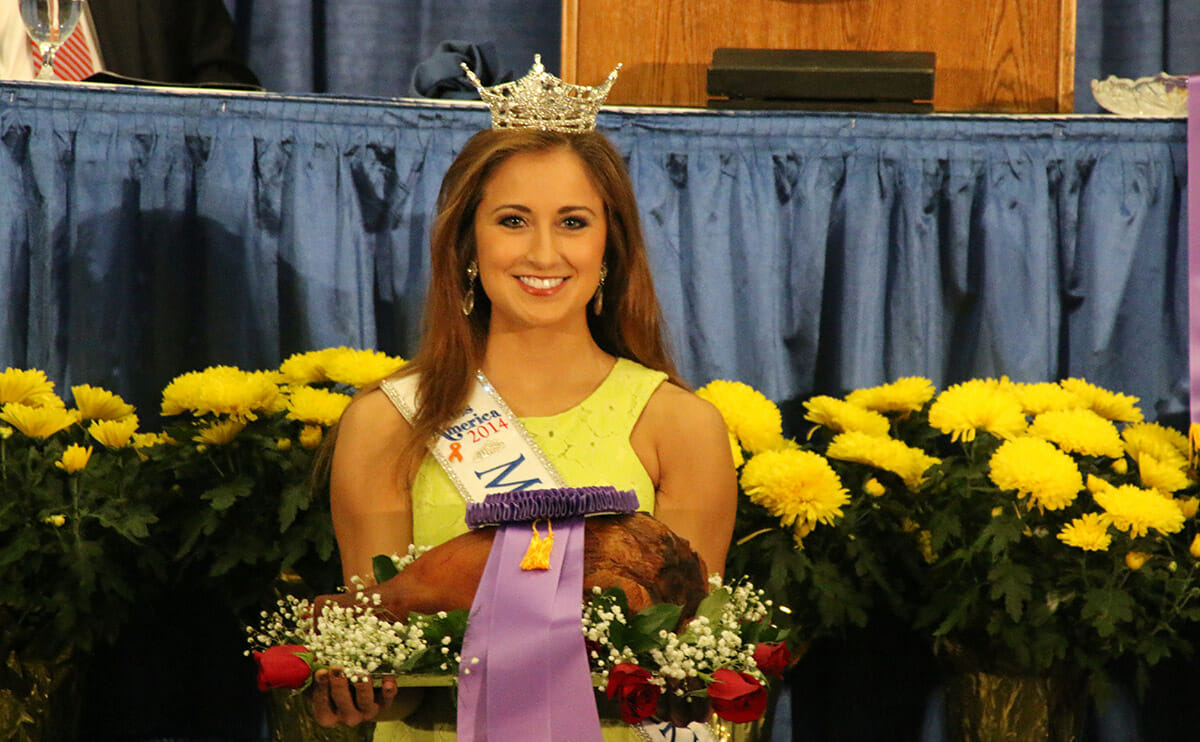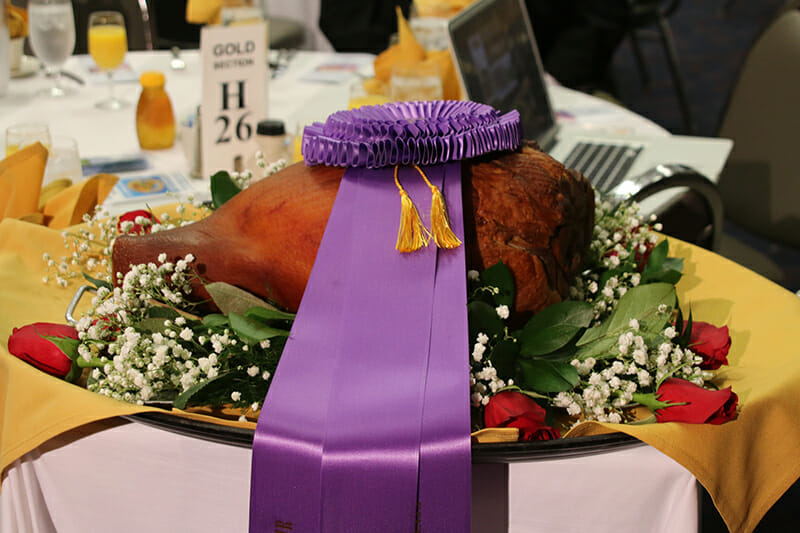The $2 Million Ham
What makes a $2 million ham so valuable?

In Kentucky, auctioning off hams for six or seven figures is a tradition of sorts. Every August a competition is held at the state fair in Louisville, where contestants enter their hams to be judged by a panel of judges. The ham that takes the top place (and the blue ribbon) is then presented at the Kentucky Farm Bureau Country Ham Breakfast & Auction where it is auctioned to the highest bidder and the money always goes to charity. Organizers and journalists both remark upon the tradition’s levity, noting that it’s as much a public relations opportunity for corporations and politicians who open their pocketbooks as it is a food contest.
Still, for the producer whose cured ham wins grand champion, the auction is a big deal.
“It normally sells for about $60, so it’s a bit amazing to us,” says Beth Drennan, who, with husband Ronny, owns country ham company Broadbent B&B Foods in Cadiz, KY, which produced the record breaking pork product. The Drennan’s prize-winning ham weighed in at 15 pounds, making that $125,865 per pound at auction.
‘It normally sells for about $60, so it’s a bit amazing to us.’
The Drennans are old hands at getting their hams past the judges and into the auction; 2014 marked their ninth win.
The judges, Ronny says, are looking for certain visual qualities: a tight and trimmed “butt face,” the flat edge of the hind leg where its severed from the body; a black butt face color with a brown ring of fat; and a taut, pecan-colored skin. The judges will inject a probe into the ham to help them smell if the ham cured fully.
The Kentucky Farm Bureau Country Ham Breakfast is an annual state fair event. It’s a 1600-person party that brings together the state’s ag leaders, elected officials and corporate officers to scarf down biscuits, eggs and, of course, ham. The Drennans, as winners, were seated at the breakfast’s lead table alongside Kentucky Governor Steve Beshear, a Democrat, U.S. Senator Mitch McConnell, a Republican, and the Kentucky Agriculture Commissioner James Comer. The winning ham is dressed on a silver platter and garnished by roses. The current Miss Kentucky parades the ham around for viewing by the bank presidents, CEOs and small business owners who bid on it.

“It’s an ironically majestic finale for a hind end that spent many of its days ignobly covered in mud,” writes Louisville-based food journalist Steve Coomes in his book “Country Ham: A Tradition of Hogs, Salt and Smoke.”
The tradition was cooked up 50 years ago when the Kentucky Farm Bureau and other state agricultural leaders were looking for ways to keep the state fair focused on its agrarian traditions.
“They were seeing that the emphasis had shifted and wanted to preserve agriculture’s role there,” said Kentucky Farm Bureau spokesperson Dan Smaldone. Part of that preservation included the country ham auction, which highlighted the state’s hog industry as well as Kentuckians’ prowess at curing ham.
The event today has little to do with ham or pork production, says Smaldone. The breakfast is an opportunity for politicians to stump before a room filled with voters, donors and reporters. And last year, Smaldone remembers, the political speeches became rather heated as Beshear and McConnell traded barbs over Obamacare.
The entire bid goes to charity, usually education or health nonprofits. Not a penny goes to the Farm Bureau or the winning ham maker.
The winning bids began accumulating their current Scrooge McDuck levels once competing bidders began combining their cash. For example, say a bank president bids $750,000. Then a doctor bids $800,000. Instead of capping it all there, the two parties decide to both throw in $800,000 to be good sports. That’s what happened in 2010, when the winning bid was $1.6 million. A pairing happened again this year.
The entire bid goes to charity, usually education or health nonprofits. Not a penny goes to the Farm Bureau or the winning ham maker, Smaldone says.
The contest brings a great deal of attention to one expensive ham, but some lament that it does little to promote appreciation for the Appalachian art of country ham, a tradition that dates back decades. Ronny recalls a farming childhood spent curing homegrown hams.
“It used to be every farmer cured ham, but there’s not too many of them left that does that,” says Drennan, who cures 12,000 hams a year. “It’s a dying art.”
Chefs are starting to pay attention, Coomes told Modern Farmer, paying top dollar for country hams made from heritage breed pigs.
“It’s like wine making, (the ham) is not the same every year,” says Coomes. “It’s a vintage.”
Follow us
This work is licensed under a Creative Commons Attribution-NoDerivatives 4.0 International License.
Want to republish a Modern Farmer story?
We are happy for Modern Farmer stories to be shared, and encourage you to republish our articles for your audience. When doing so, we ask that you follow these guidelines:
Please credit us and our writers
For the author byline, please use “Author Name, Modern Farmer.” At the top of our stories, if on the web, please include this text and link: “This story was originally published by Modern Farmer.”
Please make sure to include a link back to either our home page or the article URL.
At the bottom of the story, please include the following text:
“Modern Farmer is a nonprofit initiative dedicated to raising awareness and catalyzing action at the intersection of food, agriculture, and society. Read more at <link>Modern Farmer</link>.”
Use our widget
We’d like to be able to track our stories, so we ask that if you republish our content, you do so using our widget (located on the left hand side of the article). The HTML code has a built-in tracker that tells us the data and domain where the story was published, as well as view counts.
Check the image requirements
It’s your responsibility to confirm you're licensed to republish images in our articles. Some images, such as those from commercial providers, don't allow their images to be republished without permission or payment. Copyright terms are generally listed in the image caption and attribution. You are welcome to omit our images or substitute with your own. Charts and interactive graphics follow the same rules.
Don’t change too much. Or, ask us first.
Articles must be republished in their entirety. It’s okay to change references to time (“today” to “yesterday”) or location (“Iowa City, IA” to “here”). But please keep everything else the same.
If you feel strongly that a more material edit needs to be made, get in touch with us at [email protected]. We’re happy to discuss it with the original author, but we must have prior approval for changes before publication.
Special cases
Extracts. You may run the first few lines or paragraphs of the article and then say: “Read the full article at Modern Farmer” with a link back to the original article.
Quotes. You may quote authors provided you include a link back to the article URL.
Translations. These require writer approval. To inquire about translation of a Modern Farmer article, contact us at [email protected]
Signed consent / copyright release forms. These are not required, provided you are following these guidelines.
Print. Articles can be republished in print under these same rules, with the exception that you do not need to include the links.
Tag us
When sharing the story on social media, please tag us using the following: - Twitter (@ModFarm) - Facebook (@ModernFarmerMedia) - Instagram (@modfarm)
Use our content respectfully
Modern Farmer is a nonprofit and as such we share our content for free and in good faith in order to reach new audiences. Respectfully,
No selling ads against our stories. It’s okay to put our stories on pages with ads.
Don’t republish our material wholesale, or automatically; you need to select stories to be republished individually.
You have no rights to sell, license, syndicate, or otherwise represent yourself as the authorized owner of our material to any third parties. This means that you cannot actively publish or submit our work for syndication to third party platforms or apps like Apple News or Google News. We understand that publishers cannot fully control when certain third parties automatically summarize or crawl content from publishers’ own sites.
Keep in touch
We want to hear from you if you love Modern Farmer content, have a collaboration idea, or anything else to share. As a nonprofit outlet, we work in service of our community and are always open to comments, feedback, and ideas. Contact us at [email protected].by Andre Gallant, Modern Farmer
September 16, 2014
Modern Farmer Weekly
Solutions Hub
Innovations, ideas and inspiration. Actionable solutions for a resilient food system.
ExploreExplore other topics
Share With Us
We want to hear from Modern Farmer readers who have thoughtful commentary, actionable solutions, or helpful ideas to share.
SubmitNecessary cookies are absolutely essential for the website to function properly. This category only includes cookies that ensures basic functionalities and security features of the website. These cookies do not store any personal information.
Any cookies that may not be particularly necessary for the website to function and are used specifically to collect user personal data via analytics, ads, other embedded contents are termed as non-necessary cookies.